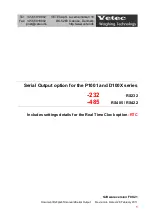
44
Installation and maintenance guide
1ZSC000563-AAX EN, REV. A, 2019-03-21
5.
Measure the capacitance (C
1
) between the outer terminal and the stud (1).
NOTE!
Refer to the table for the nominal capacitance (C
1
),
Nominal capacitance,
page
6.
Measure the capacitance (C
2
) between the stud (1) and the flange.
NOTE!
Record the capacitance (C
2
) for future reference.
7.
Install the cover (2).
CAUTION!
The test tap is not self-grounding!
The bushing can be destroyed if the test tap is not grounded. Because the capacitance (C
2
)
is usually relatively small, the test tap must never be open-circuited when applying a
voltage to the bushing. It must always be grounded or connected to an external impedance.
CAUTION!
Do not energize the bushing without the cover or a test adapter installed. The cover
connects the outermost conductive foil to ground and will prevent damage to the bushing.
CAUTION!
Make sure that the cover is correctly installed with the O-ring in place, when the bushing is
not in use. The purpose is to prevent dust and water from entering the tap.
8.
Connect the outer terminal of the bushing to the external connections.
End of instruction
5.2.5 Measurement of through-resistance
Overview
The method to use for measuring the through-resistance depends on the design of the transformer. In general,
a current is applied from bushing to bushing. The voltage drop from the outer terminal to outer terminal is
measured. The resistance is calculated with Ohm's law, U = R*I.
(U: Measured voltage drop; I: Through-current; R: Total circuit resistance).
The total through-resistance is the sum of the transformer winding, lead resistance, the bushing conductor,
and contact resistance. The additional resistance from the bushing conductor should not be more than 150 μΩ.
Because the through-resistance of the HV winding of a typical power transformer is in the order of
0.1 to 1 Ω, this is a very rough method that can only be used to detect very large faults in the current path,
such as open circuits.
Small faults in the current path can only be detected by making sensitive measurements across each
connection point, or by measuring the temperature increase during operation with an infrared sensitive
camera (thermovision).
The through-resistance of an installed bushing can only be measured from the outer terminal of one bushing,
to the outer terminal of the other bushing on the same transformer winding. The through-resistance will
include the resistance of both bushings, all connections and the transformer winding.
Because the result of the measurement depends on the temperature and the accuracy with which the
temperature can be measured, this can be a source of errors.
Summary of Contents for GSC 200
Page 40: ...40 Installation and maintenance guide 1ZSC000563 AAX EN REV A 2019 03 21 ...
Page 46: ...46 Installation and maintenance guide 1ZSC000563 AAX EN REV A 2019 03 21 ...
Page 48: ...48 Installation and maintenance guide 1ZSC000563 AAX EN REV A 2019 03 21 ...
Page 52: ...52 Installation and maintenance guide 1ZSC000563 AAX EN REV A 2019 03 21 ...













































